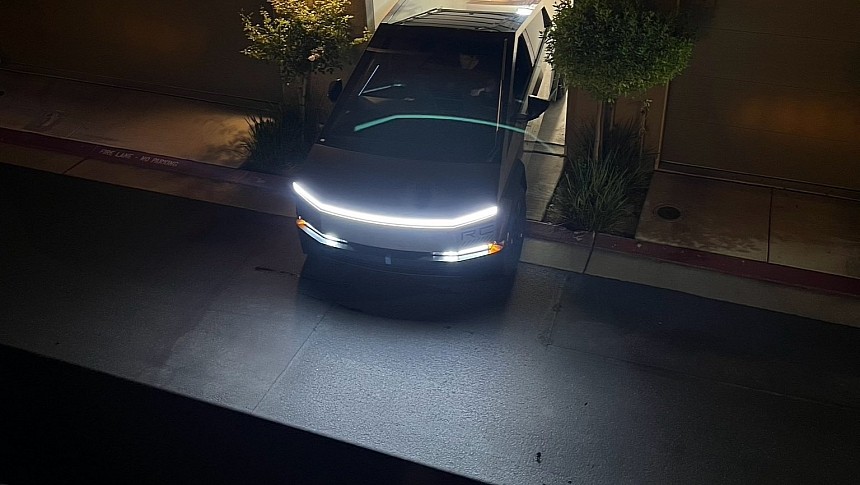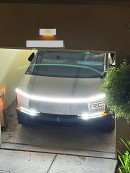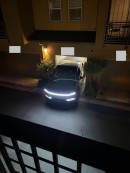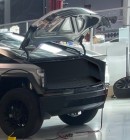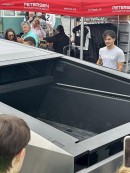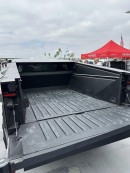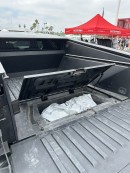Not that long ago, pictures of a Tesla Cybertruck bearing a lot of bullet marks - that were, very importantly, not holes - on its left-side doors were leaked online and, as it so often happens when it comes to anything related to Elon Musk's company, quickly started doing the rounds.
Based on the reaction these images have got, you'd think it's a miracle any of us was still alive after surviving all those times people fired their guns at our non-bulletproof cars while we were inside. You never would have known it because, for some reason, everybody was keeping it a tight secret before the Cybertruck came along, but it turns out that, deep down inside, we were all mortally scared of being shot dead in our vehicles.
Advertising a vehicle as being bulletproof can also be interpreted as lowkey fearmongering. It basically tells you the world has gone to hell, so you and your family need the safety provided by the Cybertruck to make it through. Step outside, though, and you're on your own.
"You fool," I can already hear certain people yelling, "demonstrating the truck is bulletproof is not about actually stopping bullets, but rather a clever way of showing just how tough the vehicle is. If bullets won't hurt it, just imagine how well it'll fare in a crash."
Well, yes, it probably would win in a post-crash car beauty contest, but that very rarely tends to be the priority. Usually, it's all about keeping the people inside in one piece, and that's not something you achieve by making the vehicle more rigid. Well, not all of it, at least.
The idea of crumple zones has been around for ages, and it revolves around the fact that, simply put, you either find a way to absorb some of the kinetic energy expended in a crash using the actual vehicle, or the human bodies inside will. Make the deceleration too sudden, and you won't have to worry about pieces of metal crushing the occupants because they would already be dead from all the internal injuries. The seatbelt will keep you strapped in, but there is no seatbelt for your organs.
Crumple zones are designed to absorb as much of the momentum carried over from the impact as possible and limit how much of it will be felt inside the cabin. To do that, they use certain types of materials and manufacturing procedures that allow the metal to bend and fold to the point where you won't be able to tell if it's a Mercedes-Benz or a bus, but you won't give a damn either because you'll be too happy celebrating you're still alive.
There is also the common misconception that driving a heavy vehicle somehow makes you immune to any risks out on the road. While basic physics will tell you that having greater mass is a good thing when two objects collide, you'll need a bit more thinking effort to realize there will always be heavier vehicles around, not to mention the occasional immovable object where the added pounds actually turn into a disadvantage (since they bring extra momentum) in case of a crash.
If the Cybertruck is as tough as they say, the only thing that will bend in case of a crash is the space-time continuum and, most likely, the other car involved. In other words, ignoring what we just talked about the importance of crumple zones and shock absorption, the electric pickup truck is extremely safe at the expense of the other vehicle involved.
And let's not even mention what would happen to a pedestrian if he got hit by the CT as we're not past the children's bedtime hours. Who wouldn't want their heads banged against 3-millimeter-thick (1⁄8 inch) cold-rolled stainless steel, right? On the flip side, assuming they lived, they'd never need a mask for Halloween, so there's always a positive.
Some of you will read all this and think, "but Teslas have always had an excellent crash safety record, I'm sure the Cybertruck won't be any different." That's a solid argument, but one that can't currently rely on any facts since the company has been so secretive and elusive when it came to offering any actual figures. Besides, the vibe we get is that the CT will be like no other Tesla before it, so there's no point in taking previous vehicles as reference. Or is there?
There are voices claiming that, once the whole exoskeleton thing fell through, as far as the underpinnings are concerned, the Cybertruck became little more than a pickup truck version of your Tesla model of choice. Obviously, Tesla tried to keep things around the truck's structure as murky as possible since it basically changed the initial deal by dropping the original architecture for a much more conventional one, so that's one more aspect we don't have the company's official position on.
I honestly suspect - and I have no concrete evidence to back it, hence why this is an editorial and not a piece of news - this to be the case, and I wouldn't be at all surprised if it turned out that the advertised steel was only used for the doors, with a considerably thinner and less rigid material making its way on the front panels.
I might be giving Tesla too much credit since that would actually be a smart move. The cabin is most vulnerable when hit from the side, so any added protection there is very welcome, especially since there is too little space for anything even resembling a crumple zone. Having the front behave like that of any other regular vehicle would also make sense and guarantee a more rapid government approval of the design.
It's also very Tesla-like to advertise its products as something they're not, so this would fall in line with the company's MO. Either way, the very fact we're having this conversation about such a vital aspect of the CT's build is proof of just how poorly Tesla communicates about its products during the development stage, and you will excuse me if I believe it's done on purpose.
Musk recently said they (well, it was mostly him, but you know the drill: take the credit, share the blame) "dug their own grave with the Cybertruck," and, considering everything we talked about, it's easy to see why. But I got news for Elon: he also dug Tesla's grave when he said the company was worth next to nothing if it didn't succeed in making the Full Self-Driving Beta advanced driver-assistance system work, because that looks less and less likely to happen.
A lot of people picked up on the fallacy of calling human drivers less safe while also using them as failsafe for the situations the AI can't handle. Well, I don't know about you, but when I can't solve a complicated math problem, I don't go to my first grade daughter for help (though she might surprise me, to be fair), yet that's exactly what the FSD-Beta does, according to Tesla.
There are also plenty of ongoing legal issues, apart from the public perception ones. Once those enter their final stages, don't be surprised if the whole house of cards comes crumbling down - ironically, just as Musk himself predicted. In the meantime, though, we have the November 30 Cybertruck delivery event to look out for, and it'll be interesting to see which Elon Musk will show up: the giddy, cowboy hat-wearing one, or the depressing, stuttering, incoherent wreck we heard during the recent Tesla earnings call?
Advertising a vehicle as being bulletproof can also be interpreted as lowkey fearmongering. It basically tells you the world has gone to hell, so you and your family need the safety provided by the Cybertruck to make it through. Step outside, though, and you're on your own.
"You fool," I can already hear certain people yelling, "demonstrating the truck is bulletproof is not about actually stopping bullets, but rather a clever way of showing just how tough the vehicle is. If bullets won't hurt it, just imagine how well it'll fare in a crash."
Fair point, fair point. Except it's actually a terrible one.
A lot of people still have antiquated opinions about how car crashes work. They believe you need a tough, sturdy, rigid vehicle that will slice through whatever was unfortunate enough to find itself in its path. Whichever contraption looks less mangled at the end wins.Well, yes, it probably would win in a post-crash car beauty contest, but that very rarely tends to be the priority. Usually, it's all about keeping the people inside in one piece, and that's not something you achieve by making the vehicle more rigid. Well, not all of it, at least.
The idea of crumple zones has been around for ages, and it revolves around the fact that, simply put, you either find a way to absorb some of the kinetic energy expended in a crash using the actual vehicle, or the human bodies inside will. Make the deceleration too sudden, and you won't have to worry about pieces of metal crushing the occupants because they would already be dead from all the internal injuries. The seatbelt will keep you strapped in, but there is no seatbelt for your organs.
Crumple zones are designed to absorb as much of the momentum carried over from the impact as possible and limit how much of it will be felt inside the cabin. To do that, they use certain types of materials and manufacturing procedures that allow the metal to bend and fold to the point where you won't be able to tell if it's a Mercedes-Benz or a bus, but you won't give a damn either because you'll be too happy celebrating you're still alive.
There is also the common misconception that driving a heavy vehicle somehow makes you immune to any risks out on the road. While basic physics will tell you that having greater mass is a good thing when two objects collide, you'll need a bit more thinking effort to realize there will always be heavier vehicles around, not to mention the occasional immovable object where the added pounds actually turn into a disadvantage (since they bring extra momentum) in case of a crash.
The Cybertruck seems to make itself guilty of both of these offences.
There's no way the electric pickup truck is going to be lightweight, not with that massive battery pack and the advertised thick stainless steel panels. Speaking of the latter, there are genuine reasons to ask questions about the BEV's crash worthiness as well because, while we don't yet know how they will influence the vehicle's performance during an accident, it's hard to imagine they will behave the same as a conventional setup. After all, they can stop bullets, can't they?If the Cybertruck is as tough as they say, the only thing that will bend in case of a crash is the space-time continuum and, most likely, the other car involved. In other words, ignoring what we just talked about the importance of crumple zones and shock absorption, the electric pickup truck is extremely safe at the expense of the other vehicle involved.
And let's not even mention what would happen to a pedestrian if he got hit by the CT as we're not past the children's bedtime hours. Who wouldn't want their heads banged against 3-millimeter-thick (1⁄8 inch) cold-rolled stainless steel, right? On the flip side, assuming they lived, they'd never need a mask for Halloween, so there's always a positive.
Some of you will read all this and think, "but Teslas have always had an excellent crash safety record, I'm sure the Cybertruck won't be any different." That's a solid argument, but one that can't currently rely on any facts since the company has been so secretive and elusive when it came to offering any actual figures. Besides, the vibe we get is that the CT will be like no other Tesla before it, so there's no point in taking previous vehicles as reference. Or is there?
There are voices claiming that, once the whole exoskeleton thing fell through, as far as the underpinnings are concerned, the Cybertruck became little more than a pickup truck version of your Tesla model of choice. Obviously, Tesla tried to keep things around the truck's structure as murky as possible since it basically changed the initial deal by dropping the original architecture for a much more conventional one, so that's one more aspect we don't have the company's official position on.
I honestly suspect - and I have no concrete evidence to back it, hence why this is an editorial and not a piece of news - this to be the case, and I wouldn't be at all surprised if it turned out that the advertised steel was only used for the doors, with a considerably thinner and less rigid material making its way on the front panels.
I might be giving Tesla too much credit since that would actually be a smart move. The cabin is most vulnerable when hit from the side, so any added protection there is very welcome, especially since there is too little space for anything even resembling a crumple zone. Having the front behave like that of any other regular vehicle would also make sense and guarantee a more rapid government approval of the design.
It's also very Tesla-like to advertise its products as something they're not, so this would fall in line with the company's MO. Either way, the very fact we're having this conversation about such a vital aspect of the CT's build is proof of just how poorly Tesla communicates about its products during the development stage, and you will excuse me if I believe it's done on purpose.
Musk recently said they (well, it was mostly him, but you know the drill: take the credit, share the blame) "dug their own grave with the Cybertruck," and, considering everything we talked about, it's easy to see why. But I got news for Elon: he also dug Tesla's grave when he said the company was worth next to nothing if it didn't succeed in making the Full Self-Driving Beta advanced driver-assistance system work, because that looks less and less likely to happen.
A lot of people picked up on the fallacy of calling human drivers less safe while also using them as failsafe for the situations the AI can't handle. Well, I don't know about you, but when I can't solve a complicated math problem, I don't go to my first grade daughter for help (though she might surprise me, to be fair), yet that's exactly what the FSD-Beta does, according to Tesla.
There are also plenty of ongoing legal issues, apart from the public perception ones. Once those enter their final stages, don't be surprised if the whole house of cards comes crumbling down - ironically, just as Musk himself predicted. In the meantime, though, we have the November 30 Cybertruck delivery event to look out for, and it'll be interesting to see which Elon Musk will show up: the giddy, cowboy hat-wearing one, or the depressing, stuttering, incoherent wreck we heard during the recent Tesla earnings call?
